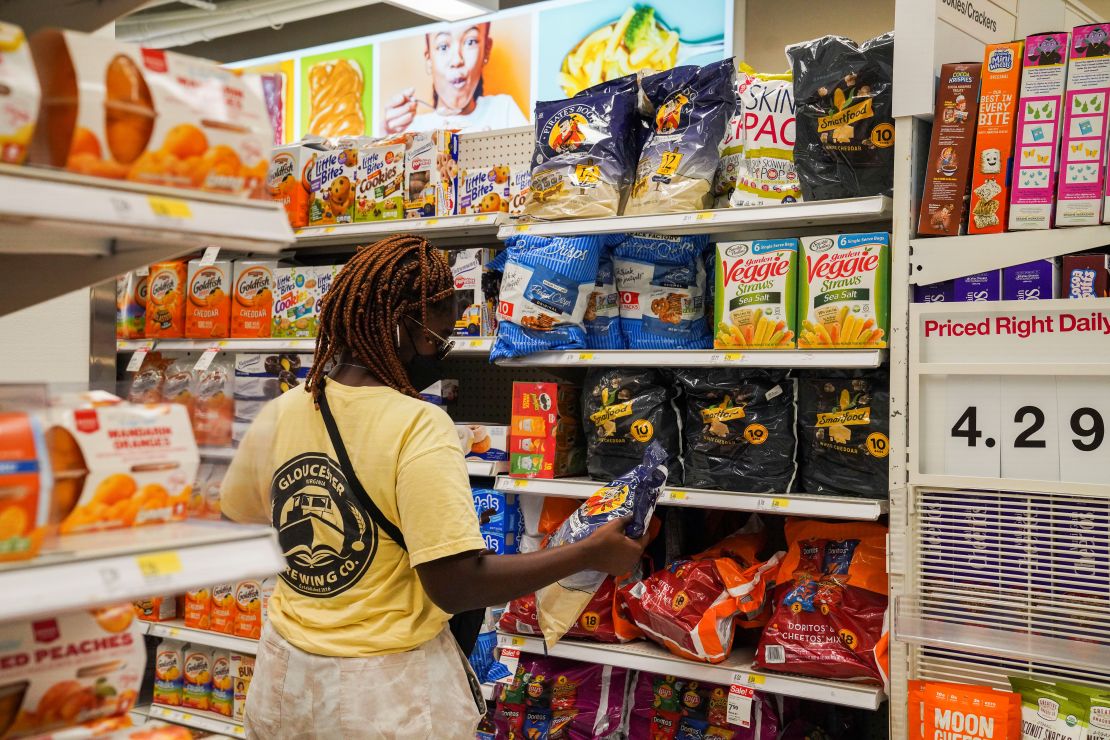Editor’s Note: This interview has been editing for length and clarity.
In its efforts to battle rising inflation, the Federal Reserve may start rolling back some of its massive pandemic-related stimulus.
In minutes from its September meeting released Wednesday, the Federal Reserve signaled that it could begin tapering its monthly purchases of Treasury and mortgage-backed securities as soon as November. The bond purchases have been supporting the US economy as the nation continues to recover from Covid and grapple with the supply chain issues that it has caused.
Julia Chatterley spoke with Mary Daly, president of the Federal Reserve Bank of San Francisco, on Thursday about the Fed news, how long inflation will last and the ‘dirty word’ we all need to stop focusing on.
Chatterley: I think a lot of people will have read those [Fed] minutes yesterday and see a group of people that are increasingly concerned about the price pressures as food costs rise, as energy costs rise amid ongoing shortages. Several of those members saying, look, it’s time to start pulling back the policy. Is that where we are?
Daly: Well, when we think about pulling back the policy, it really isn’t about tightening or removing support. It’s really dialing back the amount of support we’re adding to the economy. That’s what tapering would be — dialing back the amount of support we’re adding… We have a 2% average inflation target — we’ve made substantial further progress and actually gone over that level.
And on the labor market, if you compare where we are now to where we were in the pandemic depths, we have made tremendous progress. So that’s why we’re at the point where we feel like we can dial back the level of support we’re adding to the economy and put ourselves in a good position to continue to achieve our dual mandate goals.
Chatterley: We need to separate… the decision to perhaps pull back on some of that support — the support like bond buying — and a future decision to raise interest rates, because the time lag between those two things is many months. It could even be years.
Daly: Absolutely. And really, at this point, it is premature to start talking about rate increases. That’s a different metric. That’s the metric of eliminating employment shortfalls and being sure that we have achieved average 2% inflation that’s sustainable — and isn’t just a temporary reaction to supply chain bottlenecks — that it really is part of the ongoing fundamentals of the economy. And we’re too far away from those things to call those jobs done. So right now, we’re just talking about tapering, which again, is just dialing back the amount of support we’re continuing to add to the economy.
Chatterley: One of your Federal Reserve colleagues, Raphael Bostic, the president of the Atlanta Fed, acknowledged in his view that price rises aren’t simply so transitory. In fact, every time he mentions that word or anyone there mentions that word, they’ve got a cookie jar that they put dollars in — one dollar bills in — to sort of punish themselves, because he says it’s a dirty word. Are you still confident that the price rises that we’re seeing are going to dissipate relatively quickly? That ‘transitory’ is still appropriate, or are we in for the long haul here?
Daly: You know what I’d like to offer, is that we can step back from what word we should use or whether it’s a good or bad word. What I really want us to focus on and what I think is material for policy making, is how long do we expect these to last? And what are the driving forces of these price increases we’ve seen?
Well, they’re going to last as long as Covid is with us because Covid is causing the supply chain bottlenecks that we see across the globe. Those are translating into price increases that are eye-popping in some categories. That’s what I mean by ‘not expected to persist,’ is that they’re Covid-related and, as Covid subsides, we would expect those pressures to ease.
We’ll be back to the fundamental dynamics of the economy where inflation is much more related to the strength of the labor market and the overall strength of the economy than it is to being buoyed around or boosted by temporary price increases in used cars, which you couldn’t expect to persist. The rate of inflation on used cars can’t continue to go on like this forever because it will… spur more car creation. But right now, we have bottlenecks in semiconductors. That is Covid-related.
Chatterley: Yeah, the brilliant thing about you is you always sort of make it human, and the impact that we’re seeing on individuals…The point I think where price rises are impacting people’s ability to feed their families, for example, or afford the basic things that they need on a daily basis… [is] where the Federal Reserve has to say: ‘Okay, perhaps we’re a little bit behind the curve here and we have to tamper down on some of those price pressures in order to make sure that people can get on with their daily lives and they aren’t impacted.’ I guess that’s the key here. Are we late? Is the Federal Reserve late in tackling prices for those reasons?
Daly: [W]hen we think of people, we think of two things… Covid-related price increases versus jobs.
And I’m committed to doing both, right? Achieving price stability, which is people can count on prices not rising at these rapid rates we’ve been seeing down the road. And also making sure that they can come back to work when it’s safe — that they feel it’s safe to do so when they’re not dealing with child care and other kinds of constraints that make it hard to come back to work. This is what we mean when we say achieving the dual mandate.
And if we would pull back on accommodation for the economy, pull back our support, bridle the economy, it’s probably not going to solve the supply chain bottlenecks. In fact, I would wager a bet that it won’t solve the supply chain bottlenecks. Things like opening the ports 24/7 — that’s going to make much more of a material difference on getting these supply chains on track.
One of the things I caution us all to do is not think the Fed can do everything or that we’re behind because we see a rise in gas or food prices that isn’t expected to persist beyond when Covid is on our shores.

Chatterley: We still have 6 million people that are out of jobs compared to when we entered the pandemic… And I see the unemployment rate for African Americans, for Hispanics; it’s tough to bring those rates down. Also women, primarily, out of the labor market because of the uncertainty of schooling and being able to take those jobs even part time, never mind full time.
Talk to me about the numbers here, too, because this is important. The cost of the economy of not reducing some of these inequities that we see in the labor market. I mean we’re talking trillions of dollars over years.
Daly: We are talking trillions of dollars, and in fact, the research that we’ve done shows that we’re leaving, on average, $1.2 to $1.3 trillion just in labor market input on the table each year — even before the pandemic — because we have people on the sidelines who are of working age. They want to work, but they don’t work in the same ways. They’re either underutilized, completely un-utilized or not even in the jobs where their skills and talents would match them best.
And so this is a loss of our economic output and importantly, I think it really is important for all of us to recognize that when they’re on the sidelines, the pie, the economic pie for everyone, is smaller. So this isn’t just about helping people. This is about engaging people fully so that they can help us build and grow the economy. And the pandemic has really left a bigger scar on individuals who were least able to bear it, already underserved in this regard, and so it’s incumbent on all of us to get them back in the labor market and really get them participating like they want to do.
Chatterley: What about the discussion about further spending if Congress can manage to get its act together? …If you add more spending at a time when you’ve got these supply chain bottlenecks, too much money chasing too few goods available, that adds to some of the price pressures. There’s also… the need for infrastructure spending. How do you view the balance of more spending today versus perhaps providing other forms of support for people if they don’t get the help they need in other ways?
Daly: It’s our elected officials’ decision, so I’ll leave the details to them. But let me just give you something from — put my economist’s hat on, look through history. Historically, fiscal spending of all types is not something that — you don’t build a bridge overnight. You don’t build a roadway overnight, or even put broadband in rural areas overnight. It takes time.
And so, they’re debating what kinds of supports the economy needs for the long haul, what kinds of things are going to make us globally competitive, continue to allow us to expand our productive capacity, and use everyone in our society to their fullest potential. Those are really important things to debate, but when we think about the near-term inflation outlook, it really is not going to be directly affected by decisions about roads, bridges and things that take multiple years to put into place.
Chatterley: And President Daly, very quickly, can I just ask you about some of the recent resignations of the presidents of the Fed banks of Boston and Dallas once reports of their trading or investment activities became known? I just wanted to get your views on this. Are more guardrails needed, perhaps, for all concerned?
Daly: Well, I welcome the review that Chair [Jerome] Powell is taking up about what rules and procedures should we use to do a very simple thing: Ensure that the public trust — which is our most important asset, our most important tool — is something we can earn every single day. You know, the trading brought to light that certain things we were doing weren’t appropriate for people. They look at them and they say: ‘Well wait a minute, I don’t quite understand this.’
So I applaud Chair Powell for saying we’re going to do a review, and the office of the inspector general reviewing the actual trades themselves. These are all important things for us and whatever we — they decide and whatever the rules are, I am prepared, as well as my senior team here, to comply with them, because ultimately, again, and let me underline this, trust is our most important asset and we’re committed to earning it every day.























